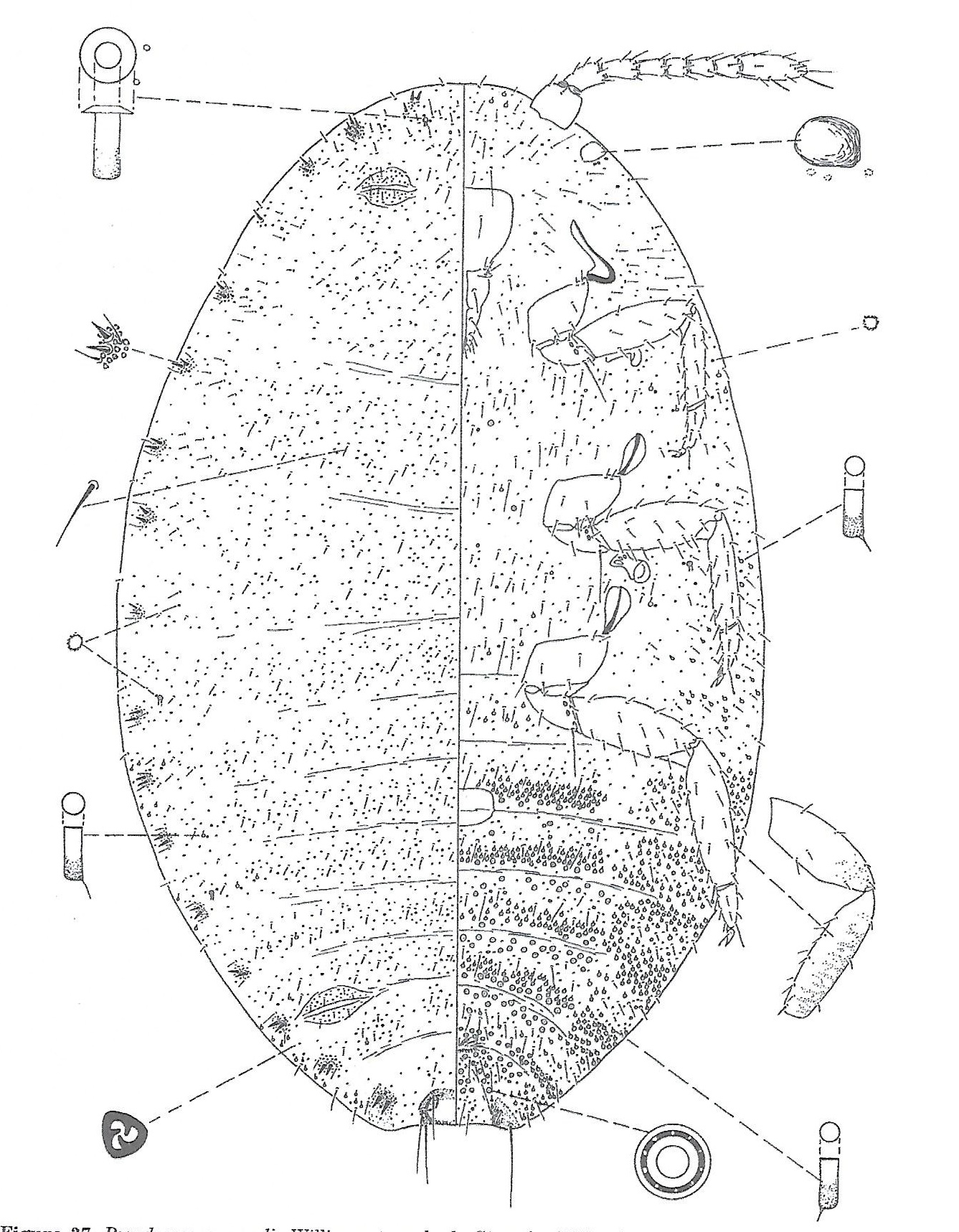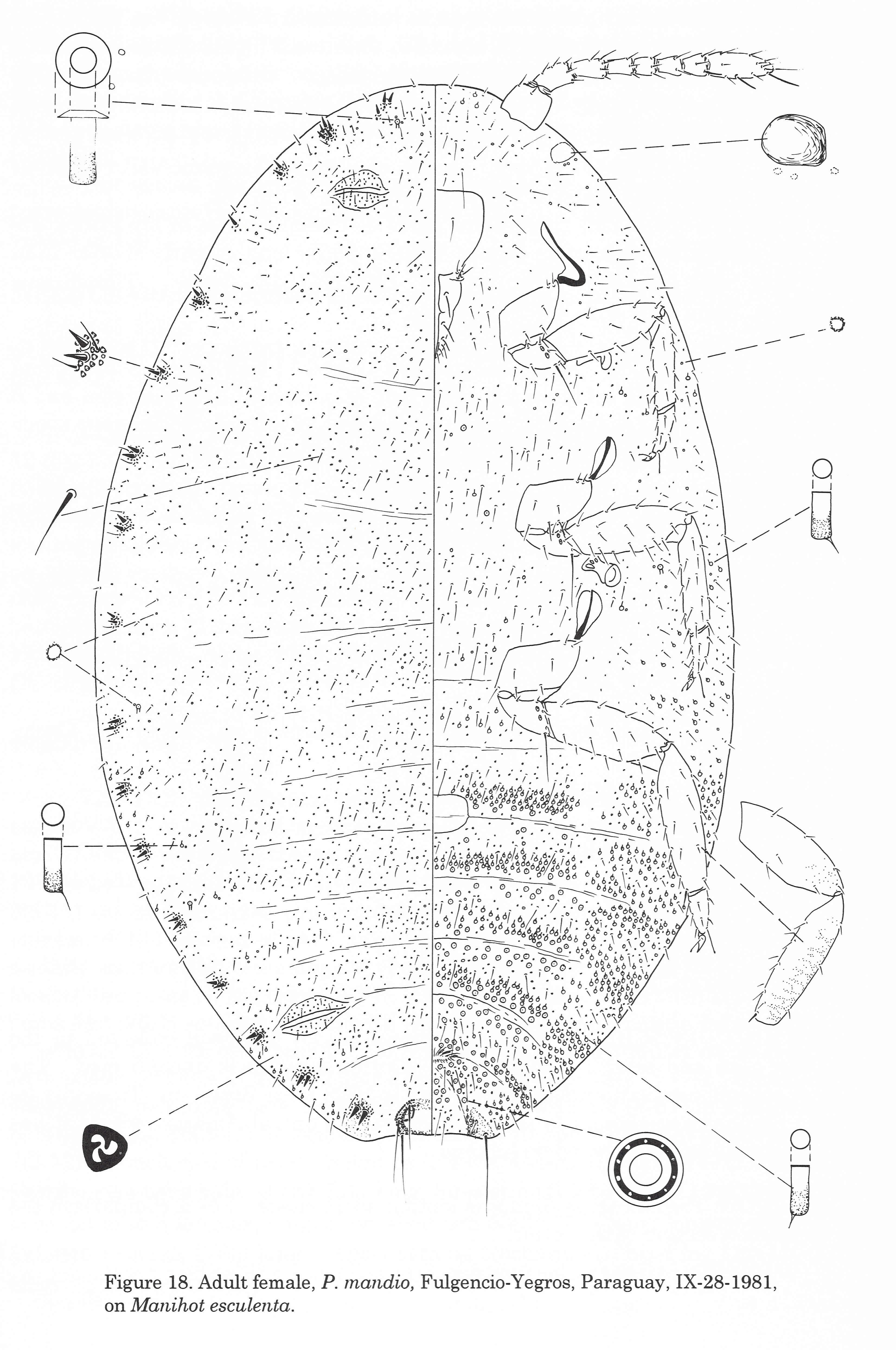Valid Names Results
Pseudococcus mandio Williams, 1985 (Pseudococcidae: Pseudococcus)Nomenclatural History
- Pseudococcus mandio Williams 1985g: 545. Type data: PARAGUAY: Fulgencio-Yegros, on Manihot esculenta. Holotype, female, Type depository: London: The Natural History Museum, England, UK; accepted valid name Illustr.
Common Names
- mandio mealybug GimpelMi1996
Ecological Associates
Hosts:
Families: 1 | Genera: 1
- Euphorbiaceae
- Manihot esculenta | BenDov1994 FoldiKo2006 GimpelMi1996 Willia1985g WilliaGr1992
Geographic Distribution
Countries: 4
- Argentina | GranarGo2018
- Bolivia | BenDov1994 Willia1985g WilliaGr1992
- Brazil | BenDov1994 GimpelMi1996 Willia1985g WilliaGr1992
- Amazonas | FoldiKo2006
- Paraguay | GimpelMi1996 Willia1985g WilliaGr1992
Keys
- GranarGo2018: pp.10-14 ( Adult (F) ) [Central & South American Pseudococcus]
- VonEllWa2016: pp.74-75 ( Adult (F) ) [Pseudococcus species present in the New World]
- ParsaKoWi2012: pp.10-Aug ( Adult (F) ) [Key to mealybugs (Hemiptera: Pseudococcidae) recorded on Manihot spp. (Euphorbiaceae) in the World]
- GimpelMi1996: pp.21 ( Adult (F) ) [World]
- WilliaGr1992: pp.427 ( Adult (F) ) [Central and South America]
Remarks
- Systematics: Pseudococcus mandio is similar to P. viburni by possessing large numbers of translucent pores on hind femur, numerous trilocular pores on segment VI, and numerous dorsomedial setae on segment VIII. The former differs by having: 2(0-4) oral rims on dorsum of abdomen; dorsal submarginal oral collars associated with most or all of cerarii 2-6; frontal oral rims normally absent; oral rims on ventral submargin from segment II to cerarius 13 absent; longest dorsal body setae 22(20-25 )µ long; 14(3-24) translucent pores on femur; hind tarsus 103(89-114)µ long; longest seta on hind trochanter 100(87-109)µ long; and 3(0-7) oral collars near cerarius 12. Pseudococcus viburni has: 13(10-18) oral rims on dorsum of abdomen; dorsal submarginal oral collars absent or strictly marginal; frontal oral rims normally present; 3(1-5) oral rims on ventral submargin from segment II to cerarius 13; longest dorsal body setae 15(1O-20)µ long; 65(15-150) translucent pores on hind femur; hind tarsus 122(114-142)µ long; longest setae on hind trochanter 144(108-157)µ long; and 10(8-16) oral collars near cerarius 12. (Gimpel & Miller, 1996)
- Structure: Oral rims reduced in number, 2(0-4) on dorsum of abdomen, restricted to submarginal areas; oral rim near frontal cerarius usually absent; dorsal oral collars associated with most abdominal cerarii on submargin; ventral oral rims usually absent; cerarius 12 with 3(0-7) associated oral collars; translucent pores on hind femur and tibia. (Gimpel & Miller, 1996)
- Biology: Occurring on the roots or underground stems of cassava.
- General Remarks: Good description and illustration of the adult female given by Williams (1985g), Williams & Granara de Willink (1992) and by Gimpel & Miller (1996).
Illustrations
Citations
- BenDov1994: catalog, 545
- CaballPaKa2021: morphology, 8
- FoldiKo2006: distribution, host, 309
- GimpelMi1996: description, distribution, host, illustration, taxonomy, 77-79
- GranarGo2018: diagnosis, distribution, host, illustration, key, taxonomy, 6, 10-14, 34
- ParsaKoWi2012: taxonomy, 9
- PegoraPr1997: chemical control, distribution, host, 164
- VonEllWa2016: key, 75
- Willia1985g: description, distribution, host, illustration, taxonomy, 545-547
- WilliaGr1992: description, distribution, host, illustration, taxonomy, 452-454




